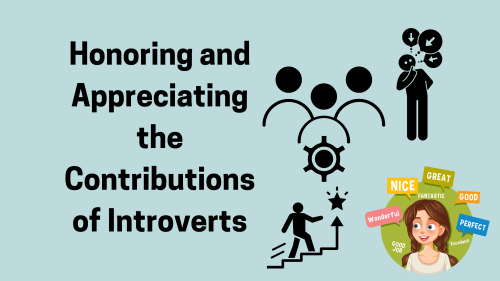
Creating Inclusive Environments: Honoring and Appreciating the Contributions of Introverts
- A Key to Inclusion
- Designing Workspaces that Foster Inclusion
- Encouraging Diverse Communication Styles
- Promoting Leadership Opportunities for Introverts
- Creating Social Spaces that Admire Individual Preferences
- Educating About Introversion
- Encouraging a Culture of Respect and Appreciation
Introduction
In a society that frequently celebrates extroversion, introverts can feel overlooked and underrated. Still, their benefits are inestimable and essential for a balanced, innovative, and inclusive world. This article explores how society can produce more inclusive surroundings that recognize and appreciate the unique strengths of wallflowers, fostering a culture where everyone can thrive.
A Key to Inclusion
Introversion is characterized by a preference for solitary or low-stimulation surroundings, where individuals feel more comfortable and energized by soul-searching and deep thinking. Wallflowers frequently exceed in conditioning that bears focus, creativity, and thoughtful analysis.
Feting and understanding these traits is the first step towards creating surroundings that appreciate and harness the strengths of wallflowers.Wallflowers bring a unique perspective to the table, frequently seeing details and connections that others might miss.
They’re complete at deep thinking, problem-working, and creative invention. By understanding these characteristics, society can appreciate the value wallflowers add and produce spaces that allow them to shine.
Designing Workspaces that Foster Inclusion
Work surroundings play a pivotal part in either stifling or nurturing the benefactions of wallflowers. Open-plan services, constant meetings, and a high position of noise can be inviting for wallflowers, reducing their productivity and overall well-being.
To foster addition, associations should consider designing workspaces that offer retired regions, private services, and inflexibility in work arrangements.Furnishing options for remote work, quiet workspaces, and areas designated for deep focus can help wallflowers perform at their stylish.
These surroundings not only have the productivity of wallflowers but also contribute to a more attentive and balanced plant culture. By taking different work styles, associations can enhance general performance and hand satisfaction.
Encouraging Diverse Communication Styles
In numerous settings, convivial communication styles, such as speaking up snappily in meetings, are frequently rewarded, while withdrawn styles may go unnoticed. To produce a more inclusive terrain, it’s essential to encourage and value different communication styles.
This includes giving wallflowers time to reflect before responding, creating openings for written feedback, and fetching benefits made in quieter, more considerate ways.Meetings can be structured to allow for wordless brainstorming sessions, followed by conversations where everyone has a chance to contribute.
Inspiring written communication, similar to detailed emails or reports, will enable wallflowers to partake in their ideas in a way that feels natural to them. By valuing different communication styles, associations can tap into a wider range of perceptivity and ideas.
Promoting Leadership Opportunities for Introverts
Leadership frequently comes with the anticipation of convivial geste, similar to constant networking and public speaking. Still, wallflowers can be largely effective leaders, bringing qualities like empathy, harkening chops, and strategic thinking to their places.
Society can promote further inclusive leadership by fostering these potencies and furnishing opportunities for wallflowers to lead in ways that suit their style.Leadership development programs can embrace training that highlights the strengths of withdrawn leadership, such as deep listening, thoughtful decision-making, and the capability to make strong, meaningful connections.
By promoting different leadership styles, associations can profit from a wider range of approaches and perspectives, leading to further innovative and effective brigades.
Creating Social Spaces that Admire Individual Preferences
Social relations are an integral part of both particular and professional life, but they can be draining for wallflowers if not managed courteously. Creating social spaces that admire individual faves involves offering a variety of commerce options, from large group events to small, intimate gatherings.
Social events should include conditioning that allows for different situations of participation, similar to platoon-structure exercises, one-on-one networking openings, and quiet ways for relaxation. By offering a range of social adjuncts, associations can ensure that everyone feels comfy and included, regardless of their social preferences.
Educating About Introversion
Education is an important tool for fostering inclusivity. By educating workers, scholars, and community members about introversion, society can break down conceptions and make a further understanding and probative culture. This can be achieved through shops, training sessions, and open conversations that punctuate the value of withdrawn traits.
Educational enterprises can concentrate on the strengths that wallflowers bring to the table, similar to their capability to hear deeply, suppose critically, and develop creative results. By raising mindfulness and upgrading understanding, society can produce surroundings where wallflowers feel valued and appreciated for who they are.
Encouraging a Culture of Respect and Appreciation
At the heart of an inclusive terrain is a culture of respect and appreciation for all individuals, regardless of their personality type. Encouraging a culture that values different benefits involves recognizing and celebrating the achievements of wallflowers, furnishing formative feedback, and fostering an atmosphere of collective respect.
Recognition programs can punctuate the benefactions of wallflowers in ways that are meaningful to them, similar to substantiated notes of appreciation or openings for further development and growth. By creating a culture that respects and values all members, associations can make stronger, more cohesive brigades.
Conclusion
Creating inclusive surroundings that recognize and appreciate the benefactions of wallflowers is essential for nurturing a balanced, innovative, and productive society. By understanding introversion, designing thoughtful workspaces, encouraging different communication modes.
Promoting inclusive leadership, esteeming individual social speeds, educating about introversion, and fostering a culture of respect and appreciation, society can ensure that wallflowers are valued and authorized to contribute their style.
